V-Cube 6
The V-Cube 6 is a 6×6×6 version of Rubik's Cube. The first mass-produced 6×6×6 was invented by Panagiotis Verdes and is produced by the Greek company Verdes Innovations SA. Other such puzzles have since been introduced by a number of Chinese companies,[1] some of which have mechanisms which improve on the original. Unlike the original puzzle (but like the 4×4×4 cube), it has no fixed facets: the center facets (16 per face) are free to move to different positions.
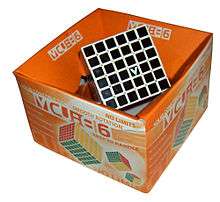
Methods for solving the 3×3×3 cube work for the edges and corners of the 6×6×6 cube, as long as one has correctly identified the relative positions of the colors — since the center facets can no longer be used for identification.
Mechanics
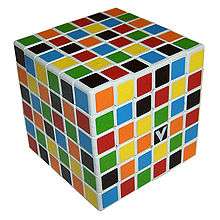
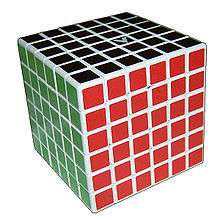
The puzzle consists of 152 pieces ("cubies") on the surface. There are also 60 movable pieces entirely hidden within the interior of the cube, as well as six fixed pieces attached to the central "spider" frame. The V-Cube 7 uses essentially the same mechanism, except that on the latter these hidden pieces (corresponding to the center rows) are made visible.[2]
There are 96 center pieces which show one color each, 48 edge pieces which show two colors each, and eight corner pieces which show three colors. Each piece (or quartet of edge pieces) shows a unique color combination, but not all combinations are present (for example, there is no edge piece with both red and orange sides, since red and orange are on opposite sides of the solved Cube). The location of these cubes relative to one another can be altered by twisting the layers of the Cube 90°, 180° or 270°, but the location of the colored sides relative to one another in the completed state of the puzzle cannot be altered: it is fixed by the distribution of color combinations on edge and corner pieces.
Currently, the V-Cube 6 is produced with white plastic as a base, with red opposite orange, blue opposite green, and yellow opposite black. One black center piece is branded with the letter V. Verdes also sells a version with black plastic and a white face, with the other colors remaining the same.
Unlike the rounded V-Cube 7, the original V-Cube 6 has flat faces. However, the outermost pieces are slightly wider than those in the center. This subtle difference allows the use of a thicker stalk to hold the corner pieces to the internal mechanism, thus making the puzzle more durable. The V-Cube 6b, which has the same "pillowed" shape as the V-Cube 7, was introduced later.
Permutations
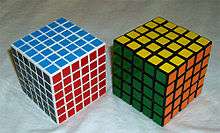
There are 8 corners, 48 edges and 96 centers.
Any permutation of the corners is possible, including odd permutations. Seven of the corners can be independently rotated, and the orientation of the eighth depends on the other seven, giving 8!×37 combinations.
There are 96 centers, consisting of four sets of 24 pieces each. Within each set there are four centers of each color. Centers from one set cannot be exchanged with those from another set. Each set can be arranged in 24! different ways. Assuming that the four centers of each color in each set are indistinguishable, the number of permutations is reduced to 24!/(246) arrangements. The reducing factor comes about because there are 24 (4!) ways to arrange the four pieces of a given color. This is raised to the sixth power because there are six colors. The total number of center permutations is the permutations of a single set raised to the fourth power, 24!4/(2424).
There are 48 edges, consisting of 24 inner and 24 outer edges. These cannot be flipped (because the internal shape of the pieces is asymmetrical), nor can an inner edge exchange places with an outer edge. The four edges in each matching quartet are distinguishable, since corresponding edges are mirror images of each other. Any permutation of the edges in each set is possible, including odd permutations, giving 24! arrangements for each set or 24!2 total, regardless of the position or orientation of any other pieces.
Assuming the cube does not have a fixed orientation in space, and that the permutations resulting from rotating the cube without twisting it are considered identical, the number of permutations is reduced by a factor of 24. This is because the 24 possible positions and orientations of the first corner are equivalent because of the lack of fixed centers. This factor does not appear when calculating the permutations of N×N×N cubes where N is odd, since those puzzles have fixed centers which identify the cube's spatial orientation.
This gives a total number of permutations of
The entire number is 157 152 858 401 024 063 281 013 959 519 483 771 508 510 790 313 968 742 344 694 684 829 502 629 887 168 573 442 107 637 760 000 000 000 000 000 000 000 000 (around 157 novemdecillion on the long scale or 157 septentrigintillion on the short scale).[3]
One of the center pieces is marked with a V, which distinguishes it from the other three in its set. This increases the number of patterns by a factor of four to 6.29×10116, although any of the four possible positions for this piece could be regarded as correct.
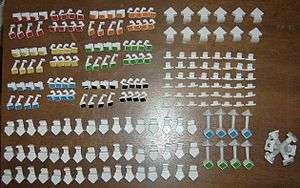
Solutions
There are a number of methods that can be used to solve a V-Cube 6. One method is to first group the center pieces of common colors together, then to match up edges that show the same two colors. Once this is done, turning only the outer layers of the cube allows it to be solved like a 3×3×3 cube.[4] However, certain positions that cannot be solved on a standard 3×3×3 cube may be reached. For instance, a single quartet of edges may be inverted, or the cube may appear to have an odd permutation (that is, two pieces must be swapped, which is not possible on the 3×3×3 cube). These situations are known as parity errors, and require special algorithms to be solved.[3]
Another similar approach to solving this cube is to first pair the edges, and then the centers. This, too, is vulnerable to the parity errors described above.[5]
Other methods solve the cube by solving a cross and the centers, but not solving any of the edges and corners not needed for the cross, then the other edges would be placed similar to the 3×3×3 Fridrich method.
Some methods are designed to avoid the parity errors described above. For instance, solving the corners and edges first and the centers last would avoid such parity errors. Once the rest of the cube is solved, any permutation of the center pieces can be solved. Note that it is possible to apparently exchange a pair of face centers by cycling 3 face centers, two of which are visually identical.
Records
The world record fastest 6×6×6 solve is 1 minute, 9.51 seconds, set by Max Park of United States on 25 January 2020 at Houston Winter 2020 in Houston, Texas.[6]
The world record mean of three solves is 1 minute, 15.90 seconds, also set by Max Park at Houston Winter 2020, with the times of 1:09.51, 1:23.93 and 1:14.27.[6]
Top 5 solvers by single solve[7]
| Name | Fastest solve | Competition |
|---|---|---|
| Max Park | 1:09.51 | Houston Winter 2020 |
| Kevin Hays | 1:14.06 | Vancouver Big Cubes Open 2019 |
| Feliks Zemdegs | 1:18.28 | Warm Up Sydney 2019 |
| Ciarán Beahan | 1:19.70 | Weston-super-Mare Open 2019 |
| Brandon Nunez | 1:21.67 | Princeton Winter 2020 |
Top 5 solvers by mean of 3 solves[8]
| Name | Fastest average | Competition |
|---|---|---|
| Max Park | 1:15.90 | Houston Winter 2020 |
| Feliks Zemdegs | 1:21.90 | Weston-super-Mare Open 2018 |
| Ciarán Beahan | 1:23.17 | Every Event Éire 2019 |
| Kevin Hays | 1:23.89 | CubingUSA Nationals 2019 |
| Seung Hyuk Nahm (남승혁) | 1:26.96 | China Championship 2018 |
See also
- Pocket Cube (2×2×2)
- Rubik's Cube (3×3×3)
- Rubik's Revenge (4×4×4)
- Professor's Cube (5×5×5)
- V-Cube 7 (7×7×7)
- V-Cube 8 (8×8×8)
- Combination puzzles
References
- 6×6×6 cubes at The Cubicle.us
- United States Patent 20070057455
- V-Cube 6 at Jaap's Puzzle Site
- "Reduction Method - Speedsolving.com Wiki". www.speedsolving.com. Retrieved 2020-05-21.
- "Cage Method - Speedsolving.com Wiki". www.speedsolving.com. Retrieved 2020-05-21.
- World Cube Association Official Results - 6x6x6 Cube
- World Cube Association Official 6x6x6 Ranking Single
- World Cube Association Official 6x6x6 Ranking Average
Further reading
- Rubik's Revenge: The Simplest Solution (Book) by William L. Mason
